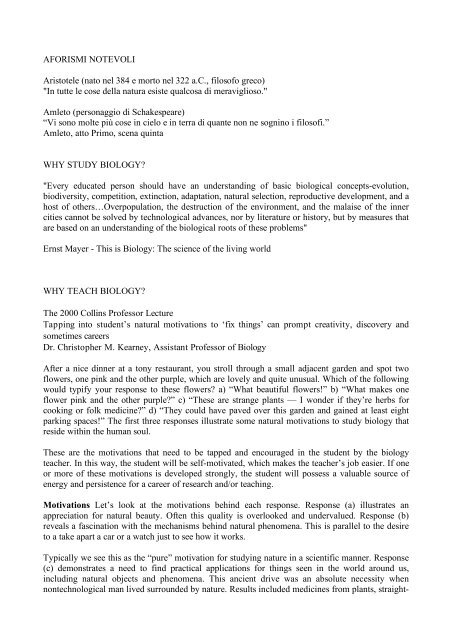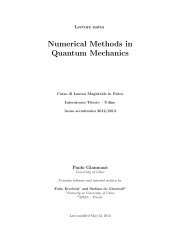AFORISMI NOTEVOLI Aristotele (nato nel 384 e morto nel 322 a.C. ...
AFORISMI NOTEVOLI Aristotele (nato nel 384 e morto nel 322 a.C. ...
AFORISMI NOTEVOLI Aristotele (nato nel 384 e morto nel 322 a.C. ...
You also want an ePaper? Increase the reach of your titles
YUMPU automatically turns print PDFs into web optimized ePapers that Google loves.
<strong>AFORISMI</strong> <strong>NOTEVOLI</strong><br />
<strong>Aristotele</strong> (<strong>nato</strong> <strong>nel</strong> <strong>384</strong> e <strong>morto</strong> <strong>nel</strong> <strong>322</strong> a.C., filosofo greco)<br />
"In tutte le cose della natura esiste qualcosa di meraviglioso."<br />
Amleto (personaggio di Schakespeare)<br />
“Vi sono molte più cose in cielo e in terra di quante non ne sognino i filosofi.”<br />
Amleto, atto Primo, scena quinta<br />
WHY STUDY BIOLOGY?<br />
"Every educated person should have an understanding of basic biological concepts-evolution,<br />
biodiversity, competition, extinction, adaptation, natural selection, reproductive development, and a<br />
host of others…Overpopulation, the destruction of the environment, and the malaise of the inner<br />
cities cannot be solved by technological advances, nor by literature or history, but by measures that<br />
are based on an understanding of the biological roots of these problems"<br />
Ernst Mayer - This is Biology: The science of the living world<br />
WHY TEACH BIOLOGY?<br />
The 2000 Collins Professor Lecture<br />
Tapping into student’s natural motivations to ‘fix things’ can prompt creativity, discovery and<br />
sometimes careers<br />
Dr. Christopher M. Kearney, Assistant Professor of Biology<br />
After a nice dinner at a tony restaurant, you stroll through a small adjacent garden and spot two<br />
flowers, one pink and the other purple, which are lovely and quite unusual. Which of the following<br />
would typify your response to these flowers? a) “What beautiful flowers!” b) “What makes one<br />
flower pink and the other purple?” c) “These are strange plants — I wonder if they’re herbs for<br />
cooking or folk medicine?” d) “They could have paved over this garden and gained at least eight<br />
parking spaces!” The first three responses illustrate some natural motivations to study biology that<br />
reside within the human soul.<br />
These are the motivations that need to be tapped and encouraged in the student by the biology<br />
teacher. In this way, the student will be self-motivated, which makes the teacher’s job easier. If one<br />
or more of these motivations is developed strongly, the student will possess a valuable source of<br />
energy and persistence for a career of research and/or teaching.<br />
Motivations Let’s look at the motivations behind each response. Response (a) illustrates an<br />
appreciation for natural beauty. Often this quality is overlooked and undervalued. Response (b)<br />
reveals a fascination with the mechanisms behind natural phenomena. This is parallel to the desire<br />
to a take apart a car or a watch just to see how it works.<br />
Typically we see this as the “pure” motivation for studying nature in a scientific manner. Response<br />
(c) demonstrates a need to find practical applications for things seen in the world around us,<br />
including natural objects and phenomena. This ancient drive was an absolute necessity when<br />
nontechnological man lived surrounded by nature. Results included medicines from plants, straight-
arrow shafts from certain shrubs, mollusk extracts for staining cloth, silk from caterpillars, shellac<br />
from insects, and the list goes on and on. Today, this drive sustains biotechnological and medical<br />
research.<br />
I should note that if you chose response (d), you either are already in the business or engineering<br />
schools or you need to contact them for an exciting career opportunity.<br />
Natural structures and systems are intrinsically beautiful, but most lay people are too busy or<br />
distracted to appreciate this beauty. The study of biology opens windows for students to see the<br />
world around them. A good biology course introduces the idea that spending time observing nature<br />
is a pleasurable experience. And it can prepare students to make sense of what they see.<br />
Idle time Let’s take a student, Joe, who has had a course in biology and one day slows down long<br />
enough to idle through a field one spring day. He spots what looks like a small piece of very shiny<br />
metal. As he picks it up, he notices that it is light and flexible. It alternates between green and<br />
brown and gold, depending on how the light hits it. Upon closer inspection, it has tiny hairs<br />
protruding from it. Joe figures out that it’s a wing cover (elytron) from a beetle. It’s difficult to put<br />
down; the colors are so wild and the structure is so precise and perfect. Next, Joe finds some water<br />
striders sitting upon the water. He’s seen them before, but he finds himself spending a good 20<br />
minutes just watching them miraculously skittering about upon the film of water formed by the<br />
cohesion of hydrogen bonds of countless water molecules. Joe then discovers some wild<br />
strawberries growing beside the water and finds some strange spots on them. When he turns the leaf<br />
upside down, he looks closely and finds a fungus growing in the spots that has the most intense<br />
orange color he’s ever seen. A powder comes off on his finger. He reasons that these must be the<br />
spores.<br />
A student like this is now hooked.<br />
The images of opalescent elytra, water films and intense orange spores are now part of his real<br />
world. The teachers of his advanced biology courses can capitalize on this as Joe is led into worlds<br />
that are not part of our normal reality. The nature of the complex weaving of biomolecules in an<br />
insect’s exoskeleton seems oddly important now that Joe has appreciated the macroscopic structure<br />
first-hand. The fact that water is drawn through a plant’s vessels by the cohesion of individual<br />
molecules makes a lot of sense — Joe spent a lot of “idle” time just watching water bend and<br />
bounce back under the weight of the water striders. And when Joe gets to see some scanning<br />
electron micrographs of the fungal spores, he discovers a new world of beauty.<br />
A fascination with mechanism The beauty of nature can grab a young student and exert its<br />
positive influence throughout her life and career. In the same way, the enjoyment of discovering<br />
how nature works is meant to last a lifetime. This fascination with mechanism is a part of all of us<br />
from an early age. If I give my 2-year-old son a complex object, such as a recently completed<br />
jigsaw puzzle or an heirloom pocket watch, he will take it apart, systematically or forcibly, until it<br />
is broken down into its constituent and fundamental pieces.<br />
The Human Genome Project is an example of this natural drive to break things down to their<br />
fundamental components, to understand the mechanism of an object. The Human Genome Project<br />
has been carried out by scientists fascinated with how the human body works, from the level of the<br />
gene up to the level of a<strong>nato</strong>my and physiology. By discovering the DNA sequence of all functional<br />
human genes, researchers now can begin the long process of determining where in the body each<br />
gene is active, characteristics of the protein each gene produces and what function that protein<br />
performs in a particular group of cells and in the body as a whole. This data will allow researchers
to have a complete understanding of the human body, from DNA to cell to tissue to organ to whole<br />
body.<br />
A need for application As much as students are interested in natural mechanisms, Baylor<br />
premedical students are sometimes more interested in defective mechanisms and especially in how<br />
to fix them. I have found in my molecular genetics course that the mechanisms behind cancer make<br />
for a tragic but fascinating story.<br />
Our body can be viewed as a society of cells, with each cell sacrificing its own replicative success<br />
for the good of the body. Unlike microbial cells, many of our cells must replicate only early in<br />
development, and then replicate no more, to preserve complex tissue and organ structures, such as<br />
the brain.<br />
Cancer involves a repudiation of this “self-control,” which results in a disruptive tumor. My<br />
students are eager to learn about arcane molecular techniques because they want to know how<br />
cancer can be corrected. A natural urge springs up within them, and I often find students suggesting,<br />
sometimes as an interruption of my lecture, sophisticated and novel ideas for controlling cancer and<br />
other diseases. What does a teacher do at this point? Should he say, “Stop interrupting with novel<br />
approaches to cancer, we’ve got to finish this chapter!”? A teacher has to design his lessons to<br />
encourage and develop this natural need to fix things.<br />
Why study biology? This is a question, from disinterested students, that drives biology teachers<br />
crazy. However, this is the question biology teachers must ask themselves. Many biologists study<br />
biology eagerly because they are entranced by the beauty of nature. So let’s make it a goal to<br />
develop this in students.<br />
Other biologists study biology to figure out how things work. If we emphasize this in our lessons,<br />
many students will hang on our words, waiting for the other shoe to fall as we tell the mysterious<br />
tale of how our bodies work.<br />
Students often study biology because they just want to ace the MCATs and move on to med school,<br />
quite frankly.<br />
Let’s move past that as teachers and ask why a student wants to be a physician.<br />
Often, it’s a desire to fix things that are broken. We can encourage and develop that natural and<br />
valuable motivation. Cutting through the massive mounds of information and course structure in<br />
order to tap these natural motivations in students is a satisfying and productive venture. If we do so,<br />
we might just get to relive what attracted ourselves to biology in the first place.
















